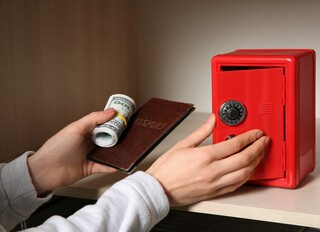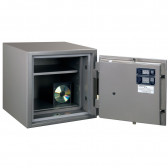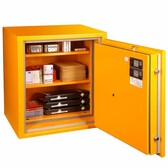Security has always been, and still is, one of the priorities. Nowadays, it is extremely important to make sure that our valuables stored at home are protected. Every one of us owns something valuable! Whether it's family heirlooms (i.e. things that are priceless), important documents, valuables, jewellery, bullion or savings in the form of cash – home safes are an indispensable part of ensuring that the things stored at home are adequately protected against theft.
In this mini-guide, we take a look at the key security features to consider when choosing the perfect home safe for your valuables. We'll cover the different types of safes, the security mechanisms available and factors to consider to make the right choice.
It is extremely important that a home safe meets our needs in terms of both security and functionality. There are a number of key factors to consider when choosing a safe, such as where it will be installed and how concealed it is, its size and capacity, and its level of security. In the rest of this article, we will take a closer look at each of these aspects to help you make an informed choice of a safe that will perfectly secure your valuables. Get ready for an exciting journey into the world of home safes and discover what options each model offers when it comes to protecting your valuables...
Mounting location and degree of concealment – so where to place a home safe?
"Where to place a home safe? How do I hide a safe at home?" – these are the most common questions from customers in the context of where to mount the safe. There are several options for the place of installation, and we can divide safes into the following categories:
- • wall safes or floor safes – these are bricked up into the wall or floor, so we can classify these two categories of safes as the most discreet. An interesting option provided it is planned – the prepared opening for the safe must have the right height, width and depth. The security of a wall or floor safe depends largely on the building conditions. Only openings in load-bearing walls, an existing niche (e.g. in the area of a staircase or basement) or another construction option that guarantees a good connection to the infill concrete are suitable for bricking up the safe. The filling space around the safe must be at least 100 mm.
- • furniture safes – these are usually small safes, with a lower weight – so they can be fitted into furniture, e.g. placed on a furniture shelf (ideal for a study or office).
- • free-standing safes – these are safes in higher security classes, weighing quite a lot. However, we also recommend that these safes are anchored to the floor or wall. It is, of course, possible to build these safes into furniture.
Size and capacity of a home safe – which model should I choose?
Home safes come in a variety of sizes and configurations to meet the different needs and expectations of users. They are an excellent way to protect valuable items (money, documents, jewellery, precious metals) from theft, fire or other mishaps. Consider what items you want to store in the safe and choose the right size and capacity of safe. Make sure it will be large enough to hold all your valuables.
Remember that a safe is a purchase that will last for years. Considering its size – don't hesitate – invest in a bigger one than you think is appropriate. We know from experience that valuables increase over time (not the other way around).
Do you want to know what to secure in a home safe, how to equip and buy it? We recommend to read our article.
Security classes for home safes – or levels of security
Security classes are information about how much resistance to burglary safes provide. The higher the level of protection a safe provides, the higher the resistance class it is assigned, and this means that more time is required to break into the safe. The higher the security class of the safe – the more valuable items can be stored in it.
Small home safes usually have lower security classes (S1, S2). Burglar-proof safes have security classes from 0-V (or VI). The higher the security class, the longer a safe is resistant to mechanical damage and the items deposited in it remain secured.
The higher the resistance class – the more robust the construction of the safe, the thicker the door, and the heavier the safe.
What else is important in addition to the security classes of safes – i.e. secure storage of various items
Some safes have additional certificates besides the burglary protection class. One of these is the one certifying and specifying fire resistance. This means that the documents or data carriers are protected in the event of fire for the period of time indicated in the certificate. Such safes have special fillings between the sheet metal shells, thanks to which the temperature inside the safe rises more slowly (than in a safe without fire resistance). The information contained in the certificate (confirmed by tests) indicates the fire resistance time.
Weapons and ammunition can also be stored in safes of at least class S1.
Types of locks used in safes
There are several types of locks that are used in safes. Below is a handful of information about safe locks. Which lock will be in your safe depends on your individual preferences and expectations.
Types of safe locks:
• key lock – the most popular option available on the market. Safes with a key lock also have the lowest price. Access to the safe is gained with a mechanical key (2 keys are usually included). However, many people do not want to 'worry' about securing keys. Therefore, other solutions are available for opening safes.
• electronic lock – it is easy to use (just enter a PIN code of a few digits), so you can open the safe quickly. Electronic locks may have additional options, for example an opening delay, revision – that is, an emergency opening with a key, a silent alarm.
• mechanical lock – do you know how prop safes are opened in American films? Bingo! It's actually a combination lock.
• biometric lock – you can open the safe using your fingerprint. The price of this solution is higher, but in this case you always have the 'key' with you.
How much does a good home safe cost?
When choosing a safe, it is important to consider your available budget. However, it is worth finding the right balance between price and quality, so that you choose a safe that meets your needs but also adequately protects what is valuable to you. Many people opt for the cheapest solution, deluding themselves into thinking that a 'metal box' will somehow protect their valuables. Unfortunately – very often after a burglary, they look for specific solutions that will best protect their valuables (cash, keys, documents, jewellery, precious metals or other collectibles). A solid safe costs from several to even tens of thousands of zlotys. These are not ordinary metal safes – only specific, classy solutions.
Summary
Home safes are an excellent way of protecting valuable items and providing a sense of security for our heads. HARTMANN TRESORE ensures that a variety of safes are available, allowing you to tailor the security to your individual needs. Before purchasing a safe, it is worth thinking carefully about your expectations and requirements in order to choose the right model.
Read also: Where to safely store weapons and ammunition at home?
Which safe lock to choose?





